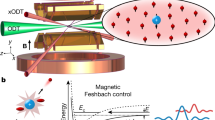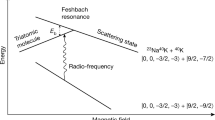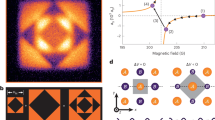Abstract
Magnetic Feshbach resonances allow control of the interactions between ultracold atoms1. They are an invaluable tool in studies of few-body and many-body physics2,3, and can be used to convert pairs of atoms into molecules4,5 by ramping an applied magnetic field across a resonance. Molecules formed from pairs of alkali atoms have been transferred to low-lying states, producing dipolar quantum gases6. There is great interest in making molecules formed from an alkali atom and a closed-shell atom such as ground-state Sr or Yb. Such molecules have both a strong electric dipole and an electron spin; they will open up new possibilities for designing quantum many-body systems7,8, and for tests of fundamental symmetries9. The crucial first step is to observe Feshbach resonances in the corresponding atomic mixtures. Very narrow resonances have been predicted theoretically10,11,12, but until now have eluded observation. Here we present the observation of magnetic Feshbach resonances of this type, for an alkali atom, Rb, interacting with ground-state Sr.
This is a preview of subscription content, access via your institution
Access options
Access Nature and 54 other Nature Portfolio journals
Get Nature+, our best-value online-access subscription
$29.99 / 30 days
cancel any time
Subscribe to this journal
Receive 12 print issues and online access
$209.00 per year
only $17.42 per issue
Buy this article
- Purchase on Springer Link
- Instant access to full article PDF
Prices may be subject to local taxes which are calculated during checkout



Similar content being viewed by others
References
Chin, C., Grimm, R., Julienne, P. & Tiesinga, E. Feshbach resonances in ultracold gases. Rev. Mod. Phys. 82, 1225–1286 (2010).
Greene, C. H., Giannakeas, P. & Pérez-Ríos, J. Universal few-body physics and cluster formation. Rev. Mod. Phys. 89, 035006 (2017).
Bloch, I., Dalibard, J. & Zwerger, W. Many-body physics with ultracold gases. Rev. Mod. Phys. 80, 885–964 (2008).
Hutson, J. M. & Soldán, P. Molecule formation in ultracold atomic gases. Int. Rev. Phys. Chem. 25, 497–526 (2006).
Köhler, T., Góral, K. & Julienne, P. S. Production of cold molecules via magnetically tunable Feshbach resonances. Rev. Mod. Phys. 78, 1311–1361 (2006).
Moses, S. A., Covey, J. P., Miecnikowski, M. T., Jin, D. S. & Ye, J. New frontiers for quantum gases of polar molecules. Nat. Phys. 13, 13–20 (2017).
Micheli, A., Brennen, G. K. & Zoller, P. A toolbox for lattice–spin models with polar molecules. Nat. Phys. 2, 341–347 (2006).
Baranov, M. A., Dalmonte, M., Pupillo, G. & Zoller, P. Condensed matter theory of dipolar quantum gases. Chem. Rev. 112, 5012–5061 (2012).
Meyer, E. R. & Bohn, J. L. Electron electric-dipole-moment searches based on alkali-metal- or alkaline-earth-metal-bearing molecules. Phys. Rev. A 80, 042508 (2009).
Żuchowski, P. S., Aldegunde, J. & Hutson, J. M. Ultracold RbSr molecules can be formed by magnetoassociation. Phys. Rev. Lett. 105, 153201 (2010).
Brue, D. A. & Hutson, J. M. Magnetically tunable Feshbach resonances in ultracold Li–Yb mixtures. Phys. Rev. Lett. 108, 043201 (2012).
Brue, D. A. & Hutson, J. M. Prospects of forming ultracold molecules in 2Σ states by magnetoassociation of alkali-metal atoms with Yb. Phys. Rev. A 87, 052709 (2013).
Regal, C. A., Ticknor, C., Bohn, J. L. & Jin, D. S. Creation of ultracold molecules from a Fermi gas of atoms. Nature 424, 47–50 (2003).
Herbig, J. et al. Preparation of a pure molecular quantum gas. Science 301, 1510–1513 (2003).
Ni, K.-K. et al. A high phase-space-density gas of polar molecules. Science 322, 231–235 (2008).
Danzl, J. G. et al. An ultracold high-density sample of rovibronic ground-state molecules in an optical lattice. Nat. Phys. 6, 265–270 (2010).
Takekoshi, T. et al. Ultracold dense samples of dipolar RbCs molecules in the rovibrational and hyperfine ground state. Phys. Rev. Lett. 113, 205301 (2014).
Hara, H., Takasu, Y., Yamaoka, Y., Doyle, J. M. & Takahashi, Y. Quantum degenerate mixtures of alkali and alkaline-earth-like atoms. Phys. Rev. Lett. 106, 205304 (2011).
Hansen, A. H. et al. Quantum degenerate mixture of ytterbium and lithium atoms. Phys. Rev. A 84, 011606(R) (2011).
Borkowski, M. et al. Scattering lengths in isotopologues of the RbYb system. Phys. Rev. A 88, 052708 (2013).
Vaidya, V. D., Tiamsuphat, J., Rolston, S. L. & Porto, J. V. Degenerate Bose–Fermi mixtures of rubidium and ytterbium. Phys. Rev. A 92, 043604 (2015).
Guttridge, A. et al. Interspecies thermalization in an ultracold mixture of Cs and Yb in an optical trap. Phys. Rev. A 96, 012704 (2017).
Aldegunde, J. & Hutson, J. M. Hyperfine structure of 2Σ molecules containing alkaline-earth-metal atoms. Phys. Rev. A 97, 042505 (2018).
Żuchowski, P. S., Guérout, R. & Dulieu, O. Ground- and excited-state properties of the polar and paramagnetic RbSr molecule: A comparative study. Phys. Rev. A 90, 012507 (2014).
Pasquiou, B. et al. Quantum degenerate mixtures of strontium and rubidium atoms. Phys. Rev. A 88, 023601 (2013).
Acknowledgements
This project has received funding from the European Research Council (ERC) under the European Union’s Seventh Framework Programme (FP7/2007-2013) (Grant agreement No. 615117 QuantStro). B.P. thanks the NWO for funding through Veni grant No. 680-47-438. P.S.\(\dot{{\rm{Z}}}\). thanks the National Science Center for support from grant 2017/25/B/ST4/01486. J.M.H. thanks the UK Engineering and Physical Sciences Research Council for support under Grant No. EP/P01058X/1.
Author information
Authors and Affiliations
Contributions
V.B., A.C. and L.R. performed the experiments. B.P. and F.S. supervised the experimental work. P.S.\(\dot{{\rm{Z}}}\). and J.M.H. contributed theoretical analysis. All authors were involved in analysis and discussions of the results and contributed to the preparation of the manuscript.
Corresponding author
Ethics declarations
Competing interests
The authors declare no conflict of interest.
Additional information
Publisher’s note: Springer Nature remains neutral with regard to jurisdictional claims in published maps and institutional affiliations.
Supplementary information
Supplementary Information
Supplementary Information
Rights and permissions
About this article
Cite this article
Barbé, V., Ciamei, A., Pasquiou, B. et al. Observation of Feshbach resonances between alkali and closed-shell atoms. Nature Phys 14, 881–884 (2018). https://doi.org/10.1038/s41567-018-0169-x
Received:
Accepted:
Published:
Issue Date:
DOI: https://doi.org/10.1038/s41567-018-0169-x
This article is cited by
-
Observation of Feshbach resonances between a single ion and ultracold atoms
Nature (2021)
-
Quo vadis now, cold molecules?
Nature Physics (2018)



